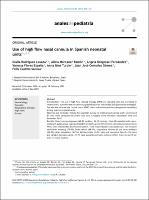| dc.contributor | Vall d'Hebron Barcelona Hospital Campus |
| dc.contributor.author | Rodriguez Losada, Olalla |
| dc.contributor.author | Montaner Ramón, Alicia |
| dc.contributor.author | Gregoraci Fernández, Angela |
| dc.contributor.author | Flores España, Vanessa |
| dc.contributor.author | Turpin, Anna Gros |
| dc.contributor.author | Comuñas Gómez, Juan José |
| dc.contributor.author | Castillo Salinas, Félix |
| dc.date.accessioned | 2022-09-09T09:39:26Z |
| dc.date.available | 2022-09-09T09:39:26Z |
| dc.date.issued | 2022-04 |
| dc.identifier.citation | Losada OR, Ramón AM, Fernández AG, España VF, Turpin AG, Gómez JJC, et al. Use of high flow nasal cannula in Spanish neonatal units. An Pediatría (English Ed). 2022 Apr;96(4):319–25. |
| dc.identifier.issn | 2341-2879 |
| dc.identifier.uri | https://hdl.handle.net/11351/8104 |
| dc.description | Nounat; Teràpia respiratòria; Enquesta |
| dc.language.iso | eng |
| dc.publisher | Elsevier |
| dc.relation.ispartofseries | Anales de Pediatría (English Edition);96(4) |
| dc.rights | Attribution-NonCommercial-NoDerivatives 4.0 International |
| dc.rights.uri | http://creativecommons.org/licenses/by-nc-nd/4.0/ |
| dc.source | Scientia |
| dc.subject | Infants nadons |
| dc.subject | Oxigenoteràpia |
| dc.subject | Enquestes |
| dc.subject.mesh | Infant, Newborn |
| dc.subject.mesh | Oxygen Inhalation Therapy |
| dc.subject.mesh | Surveys and Questionnaires |
| dc.title | Use of high flow nasal cannula in Spanish neonatal units |
| dc.title.alternative | Utilización de las cánulas nasales de alto flujo en las unidades neonatales españolas |
| dc.type | info:eu-repo/semantics/article |
| dc.identifier.doi | 10.1016/j.anpede.2021.02.015 |
| dc.subject.decs | recién nacido |
| dc.subject.decs | tratamiento por inhalación de oxígeno |
| dc.subject.decs | encuestas y cuestionarios |
| dc.relation.publishversion | https://doi.org/10.1016/j.anpede.2021.02.015 |
| dc.type.version | info:eu-repo/semantics/publishedVersion |
| dc.audience | Professionals |
| dc.contributor.organismes | Institut Català de la Salut |
| dc.contributor.authoraffiliation | [Losada OR, Ramón AM, España VF, Turpin AG, Gómez JJC, Salinas FC] Vall d’Hebron Hospital Universitari, Barcelona, Spain. [Gregoraci Fernández A] Hospital Universitario Dr. Josep Trueta, Girona, Spain |
| dc.identifier.pmid | 35523688 |
| dc.identifier.wos | 000802871000006 |
| dc.rights.accessrights | info:eu-repo/semantics/openAccess |

